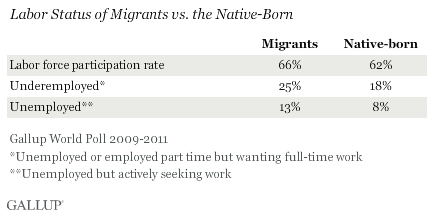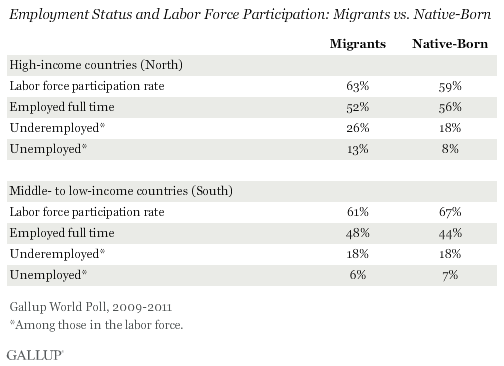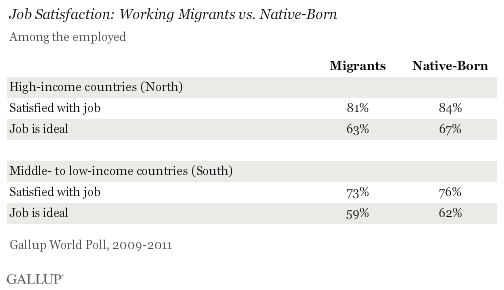WASHINGTON, D.C. -- The majority of migrants worldwide are part of the labor force of their adopted countries, but they are more likely than the native-born to be underemployed or unemployed.

These findings, featured in the International Organization for Migration's World Migration Report 2013, are based on Gallup World Poll interviews with nearly 25,000 first-generation migrants and 442,000 native-born residents in 150 countries between 2009 and 2011. Gallup groups migrants and the native-born by whether they live in high-income economies (referred to as "the North") or middle- to low-income economies (referred to as "the South").
Migrants in High-Income Countries Particularly Likely to Be Underemployed, Unemployed
Migrants living in high-income countries are slightly more likely than the native-born to be part of the workforce. But migrants are less likely to work full time for an employer -- 52% and 56%, respectively -- and are more likely to be underemployed or unemployed.
In middle- to low-income countries, on the other hand, migrants are less likely than the native-born to be part of the workforce. They are, however, more likely to work full time for an employer -- 48% vs. 44% -- and are just as likely as the native-born to be underemployed or unemployed.

Migrants Less Satisfied With Their Jobs
Gallup's definition of underemployment does not address whether migrants are working below their skill or education levels. And migrant workers -- who are increasingly arriving in destination countries without jobs -- tend to fill vacant jobs, sometimes taking positions that they are over-qualified for or working in dangerous environments.
Gallup data do show that employed migrants generally report being less satisfied with their jobs than the native-born. Working migrants who have moved from one high-income economy to another (North to North) are less likely than the native-born to say they are satisfied with their job -- 75% and 84%, respectively. They are also less likely to say that their job is the ideal one for them -- 59% vs. 67%.

Employed migrants who have moved from a middle- to low-income economy to a high-income economy (South to North) are as likely to be satisfied with their jobs as the native-born, but they are less likely than the native-born to say their job is ideal.
Employed migrants who have moved from one middle- to low-income economy to another (South to South), on the other hand, are less satisfied with their jobs than the native-born and are less likely to consider their job ideal. Job satisfaction among North-to-South migrants is comparable with that of the native-born.
Implications
A lack of good jobs at home is one of the reasons many migrants leave their countries. But not all migrants find jobs when they arrive in their new country. Many do appear more likely to be employed full time for an employer than if they stayed home -- particularly those moving South to North -- but they are also more likely to not find jobs or to find jobs that do not make full use of their capacity. Migrants who move from South to South, on the other hand, are less likely to be underemployed or unemployed than if they had stayed home.
IOM and Gallup will be presenting results from the World Migration Report at events in Washington, D.C., and Vilnius, Lithuania, in coming weeks. Read the full report.
For complete data sets or custom research from the more than 150 countries Gallup continually surveys, please contact us.
Survey Methods
Results are based on Gallup World Poll data collected across 150 countries and areas in 2009, 2010, and 2011. The typical sample size was 1,000 per country per year. Projection weighting was performed so that each country's data are proportional to the total world population. A total of 466,689 adults were included in the analysis, including 441,901 native-born residents and 24,788 first-generation migrants. Countries were classified as "North" (high-income economies) or "South" (middle- to low-income economies) according to World Bank categories. Migrants surveyed were born in 188 countries (51 of which were in the North and 137 were in the South) and lived in 150 destination countries (40 in the North, 110 in the South).
For more complete methodology and specific survey dates, please review Gallup's Country Data Set details.
